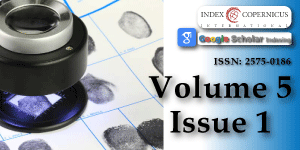Victim of violent death: what is the role of alcoholemia?
Main Article Content
Abstract
Introduction: The tendency to impulsive behaviors and/or violence is exacerbated after alcohol consumption. Still, the relation between alcohol/violent deaths reported in the literature is not accurate, and in general, alcohol is only seen as a trigger to aggressive actions. The relationship of the victims with their blood alcohol is less studied. They were especially concerned about the role of alcohol as a risk factor for victims of unnatural death. Thus, our goal is to check the influence of alcohol in victims of violent deaths as homicides, suicides, and accidents.
Materials and methods: Retrospectively the medical records of 805 autopsies performed at the Institute of Forensic Medicine (IML) of Franco da Rocha, in the period 2001 to 2017 were reviewed. The variables studied were sex, age, types of violent death rates, and alcohol - these were considered positive when above 0.3 mg/ml.
The dosage of blood alcohol concentration (BAC) was performed using samples of 10 ml of blood collected at necropsy, is preferably taken from the cardiac chambers or of the right femoral vein. Dosages of alcohol in blood samples were done in the Forensic Toxicology Center of the IML by gas chromatography, using the technique of separation “headspace” and double column.
Results: Drug testing for alcohol was available for 488 (79.1%) of 617 necropsies. Of the 617 subjects studied, 532 (85.7%) were male, and 85 (13.8%) were females (with high rates of adolescents). The vast majority (n = 230) were killed, and 40.5% of victims had BAC above 0.3 mg/ml of blood. Traffic accidents came next, accounting for 181 deaths, with 41% of victims presenting positive BAC.
Discussion: High blood alcohol levels of the victims were associated mainly with the genesis of accidents (drowning, falls, traffic, aspiration/ smothering) and murder (with impaired ability to resist or by causing the release of impulses to engage in violent situations), about 40% of cases.
Conclusion: Our results indicate that alcohol abuse is a risk factor for victims of violent death. In these cases, alcohol has two types of action. Direct: contributes to accidents of various kinds - from traffic by decreasing powers of concentration, attention, and loss of reflexes, to other types of accidents such as drowning, falls, swallowing disorders causing airway obstruction, and mechanical asphyxia. And they were indirect, making it easier for individuals to engage in conflict (and thus become victims of crimes).
Article Details
Copyright (c) 2021 Miziara ID, et al.

This work is licensed under a Creative Commons Attribution 4.0 International License.
Ministério da Saúde. Sistema de Informação sobre Mortalidade. 2010. http://www2.datasus.gov.br/DATASUS/index.php?area=040701
Lockemann U, Heinemann A, Wischhusen F, Ewerwahn J, Püschel K. Frequently misinterpreted blood alcohol concentrations in (sudden) natural and unnatural death. Versicherungsmedizin. 1995; 47: 15-17. PubMed: https://pubmed.ncbi.nlm.nih.gov/7709500/
Enache A, Chatzinnikolaou F, Enache F, Enache B. The analysis of lethal traffic accidents and risk factors. Legal Medicine. 2009; 11: S327-S330. PubMed: https://pubmed.ncbi.nlm.nih.gov/19254871/
Abel EL, Zeindenberg P. Age, Alcohol and violent death: a postmortem study. J Stud Alcohol. 1985; 46: 228-231. PubMed: https://pubmed.ncbi.nlm.nih.gov/4010300/
Jena S, Mountany L, Muller A. A demographic study of homicide-suicide in the Pretoria region over a 5 year period. Journal of Forensic and Legal Medicine. 2009; 16: 261-265. PubMed: https://pubmed.ncbi.nlm.nih.gov/19481707/
Skibin L, Bilban M, Balazic J. Harmful alcohol use of those who died a violent death-The extended region of Ljubljana 1995-1999. Forensic Sci Int 2005; 147: S49-52. PubMed: https://pubmed.ncbi.nlm.nih.gov/15694729/
Fonseca AM, Galduroz JCF, Tondowski CS, Noto NA. Alcohol-related domestic violence: a household survey in Brazil. Rev Saúde Pública 2009; 43: 743-749. PubMed: https://pubmed.ncbi.nlm.nih.gov/19722004/
Martín FM. La Violencia en la pareja. Rev Panam Salud Publica.1999; 5: 245-257.
Hall J, Goodall EA. Alleged drug facilitated sexual assault (DFSA) in Northern Ireland from 1999 to 2005. A study of blood alcohol levels. J Forensic Legal Med. 2008; 15: 497–504. PubMed: https://pubmed.ncbi.nlm.nih.gov/18926501/
Abramovay M, Castro GM. Drogas nas escolas. Brasília: UNESCO, 2005.
Heninger M, Hanzlick R. Nonnatural Deaths of Adolescents and Teenagers Fulton County, Georgia, 1985–2004. Am J Forensic Med Pathol 2008; 29: 208–213. PubMed: https://pubmed.ncbi.nlm.nih.gov/18725773/
Carlini EA, Galduróz JC, Noto AR, Carlini CM, Oliveira, LG, et al. II Levantamento domiciliar sobre o uso de drogas psicotrópicas no Brasil: estudo envolvendo as 108 maiores cidades do país - 2005. São Paulo: Páginas & Letras; 2007.
Ponce JC, Andreuccetti G, Jesus MGS, Leyton V, Muñoz DR. Álcool em vítimas de suicídio em São Paulo. Rev Psiq Clín.2008; 35: 13-16.
Andreuccetti G, Cherpitel CJ, Carvalho HB, Leyton V, Miziara ID, et al. Alcohol in combination with illicit drugs among fatal injuries in Sao Paulo, Brazil: An epidemiological study on the association between acute substance use and injury. Injury. 2018; 49: 2186-2192. PubMed: https://pubmed.ncbi.nlm.nih.gov/30270012/
Hanzlick R. Ethanol Concentration in Decomposing Bodies: Another Look, Less Concern. Am J Forensic Med Pathol. 2009; 30: 88-89. PubMed: https://pubmed.ncbi.nlm.nih.gov/19237865/

